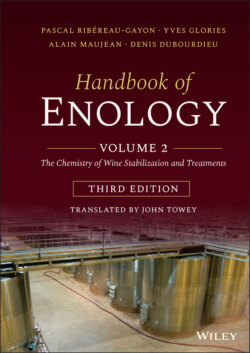Читать книгу Handbook of Enology, Volume 2 - Pascal Ribéreau-Gayon - Страница 39
1.7.2 Slow Cold Stabilization, Without Tartrate Crystal Seeding
ОглавлениеThis is the traditional technology for the bitartrate stabilization of wine. Before wineries were equipped with refrigeration and air‐conditioning systems, wines were simply exposed to natural cold by opening the cellar doors during the coldest winter weather.
The temperature may decrease at varying rates. It is gradual if the wine is chilled by means of a submerged refrigerating rod in the tank. It may be much faster in a normal installation (Section 12.4.4, Figure 12.1) including a plate heat exchanger to recover energy from the treated wine and reduce the temperature of wine to −4°C more rapidly prior to treatment. It is known (Section 12.4.4) that faster cooling promotes more complete precipitation of the tartrate in the form of small crystals.
Heat‐insulated tank rooms, equipped with heating/cooling systems, are also used. The wines are stored in uninsulated tanks with a high heat transfer coefficient, such as stainless steel. The entire room is maintained at the desired temperature, keeping the wine at a negative temperature for 8–10 days (white wines) or up to several weeks, in the case of red wines (Blouin, 1982).
The treatment temperature is generally defined by the following rule:
(1.12)
This rule is deduced from the equation defining the freezing temperature of wine according to its alcohol content:
(1.13)
Slow stabilization is tending to evolve toward pseudo‐contact technology by seeding with 30–40 g/hl of cream of tartar, agitating for 36 hours and ensuring that the wine does not oxidize. Paddle agitators with variable speed motors are the most efficient, also ensuring that only a minimal amount of oxygen is dissolved in the wine. There is a significant risk of excessive oxidation as gases dissolve more readily at low temperatures. It is recommended that the agitation rate should be monitored by measuring the optical density at 420 nm. In a white wine that has not suffered oxidation, this value decreases by 10% during cold stabilization. Seeding with 20–40 g/hl of KHT should be envisaged if, for example, natural chilling of the wine has produced some crystallization, so that it is in a less supersaturated state.
Slow stabilization often causes loss of color (OD at 520 nm) in both red and white wines. It is therefore recommended to reduce the length of treatment by adding small particles of cream of tartar, which are easier to maintain in a homogeneous suspension. Another advantage of seeding is that the wine may be maintained at a less cold temperature (−2°C instead of −4°C).
It has been demonstrated on a production scale (360 hl tanks) that the stabilization time for a white wine treated with 30 g/hl of bentonite, maintained at −2°C and seeded with 30 g/hl of cream of tartar, may be reduced to 62 hours (including 24 hours without agitation before filtration), instead of six days for the standard treatment. Under these conditions, the wine was found to be perfectly stabilized (TSat = 7°C).
